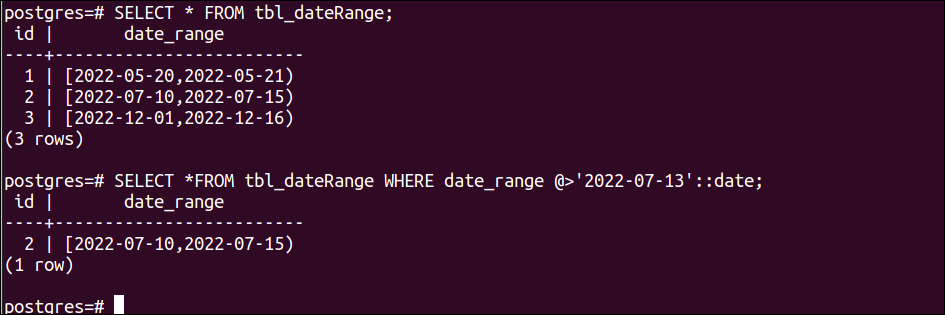| Range Types | Purpose |
|---|---|
| int4range | It defines the range of integers. |
| int4multirange | It defines the multi-range integers. |
| int8range | It defines the range of big integers. |
| int8multirange | It defines the multi-range big integers. |
| numrange | It defines the range of numbers. |
| nummultirange | It defines the multi-range of numbers. |
| tsrange | It defines the range of timestamp without the time zone. |
| tsmultirange | It defines the multi-range of timestamp without the time zone. |
| tstzrange | It defines the range of timestamp with the time zone. |
| tstzmultirange | It defines the multi-range of timestamp with the time zone. |
| daterange | It defines the range of date. |
| datemultirange | It defines the multi-range of date. |
Pre-requisites:
You have to install the latest version of PostgreSQL packages on the Linux operating system before executing the SQL statements shown in this tutorial. Run the following commands to install and start the PostgreSQL:
$ sudo systemctl start postgresql.service
Run the following command to login to PostgreSQL with root permission:
PostgreSQL range data type examples:
Before creating any table with the Boolean data type you have to create a PostgreSQL database. So, run the following command to create a database named ‘testdb’:
The following output will appear after creating the database:
A. Use of integer range data type
Create a table named ‘tbl_intRange’ in the current database with two fields. Here, the first field name is id which is the primary key of the table. The value of this field will be incremented automatically when a new record will insert. The second field name is int_range and the data type is INT4RANGE.
id SERIAL PRIMARY KEY,
int_range INT4RANGE );
The following output will appear if the table is created successfully.
Run the following INSERT query to insert three records into the tbl_intRange table:
VALUES ('[1, 10)'::int4range),
('[1, 20)'::int4range),
('[1, 30)'::int4range);
The following output will appear after executing the above query:
Run the following SELECT query to read all records from the tbl_intRange:
Run the following SELECT query to read those records from the tbl_intRange WHERE int_range is greater than 12:
The following output will appear after executing the above SELECT queries:
B. Use of numeric range data type
Create a table named ‘tbl_numRange’ in the current database with two fields. Here, the first field name is id which is the primary key of the table. The value of this field will be incremented automatically when a new record will insert. The second field name is num_range and the data type is NUMRANGE.
id SERIAL PRIMARY KEY,
num_range NUMRANGE );
Run the following INSERT query to insert three records into the tbl_numRange table:
VALUES (numrange(20, 40)),
(numrange(100, 500));
The following output will appear after executing the above queries:
Run the following SELECT query that will read all records from the tbl_numRange:
The following output will appear after executing the above SELECT query:
C. Use of timestamp range data type
Create a table named ‘tbl_timeRange’ in the current database with two fields. Here, the first field name is id which is the primary key of the table. The value of this field will be incremented automatically when a new record will insert. The second field name is timeRange and the data type is TSRANGE.
id SERIAL PRIMARY KEY,
timeRange TSRANGE);
Run the following INSERT query to insert three records into the tbl_timeRange table:
VALUES ('[2022-05-20 10:20:30, 2022-05-21 10:20:15)'),
('[2022-09-13 9:30:15, 2022-09-14 11:10:20)');
The following output will appear after executing the above queries:
Run the following SELECT query that will read all records from the tbl_timeRange:
The following output will appear after executing the above SELECT query:
D. Use of date range data type
Create a table named ‘tbl_dateRange’ in the current database with two fields. Here, the first field name is id which is the primary key of the table. The value of this field will be incremented automatically when a new record will insert. The second field name is date_range and the data type is DATERANGE.
id SERIAL PRIMARY KEY,
date_range DATERANGE);
Run the following INSERT query to insert three records into the tbl_dateRange table:
VALUES ('[2022-05-20, 2022-05-21)'),
('[2022-07-10, 2022-07-15)'),
('[2022-12-01, 2022-12-16)');
The following output will appear after executing the above queries:
Run the following SELECT query that will read all records from the tbl_dateRange:
Run the following SELECT query that will read those records from the tbl_dateRange where the date value of the date_range field is greater than ‘2002-07-13’.
The following output will appear after executing the above queries:
Conclusion:
Different uses of range data types of PostgreSQL have been shown in this tutorial by using multiple tables. The new PostgreSQL users will be able to use the range of data types in their tables after reading this tutorial.










